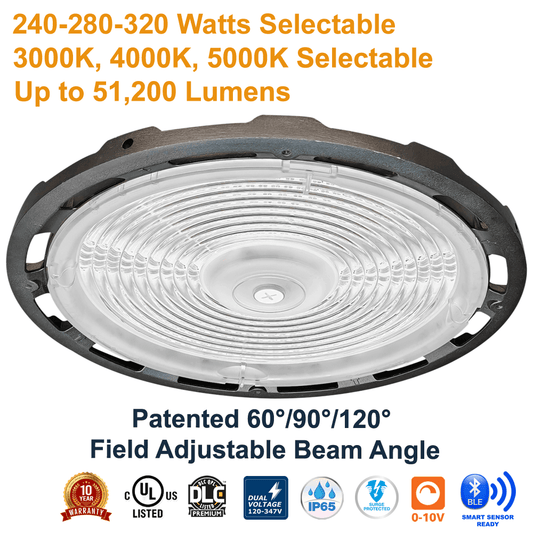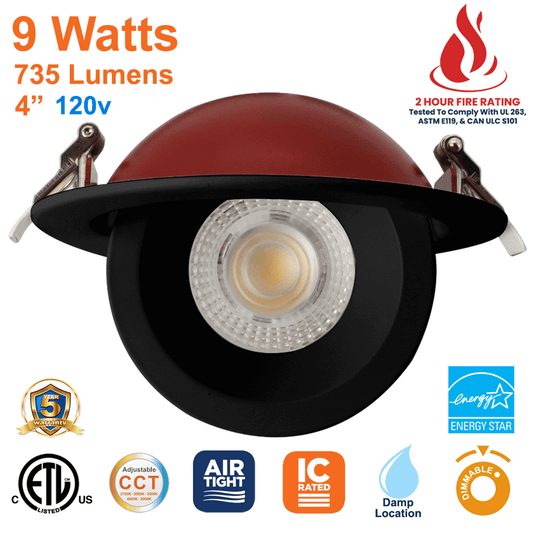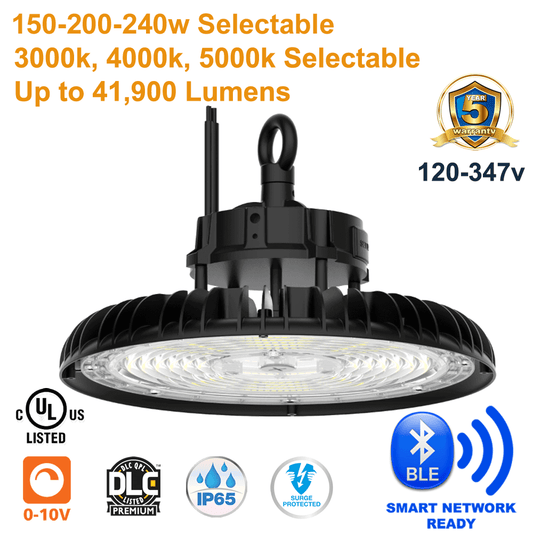In this guide we'll look at the intricacies of Warehouse Lighting Controls, providing insights on the transition from traditional lighting systems to advanced LED Warehouse Lighting, the role of motion sensors, occupancy sensors, and the integration of Networked Lighting Controls (NLCs).
Summary
Warehouse Lighting Controls have become essential in modern warehouses, enhancing efficiency, reducing energy consumption, and improving overall lighting quality. This guide explores the transition from traditional lighting systems to advanced LED Warehouse Lighting, the role of motion sensors, occupancy sensors, and the integration of NLC smart lighting solutions. By the end of this article, you will have a comprehensive understanding of how Warehouse Lighting Controls can transform your space, making it more energy-efficient, responsive, and adaptable to varying needs.
Table of Contents
- Why Has LED Lighting Become the Standard for Warehouse Lighting?
- What Are Some of the Traditional Warehouse Lighting Controls?
- Why Have Networked Lighting Controls (NLCs) Become the Most Popular Warehouse Lighting Control Systems?
- Why Are NLCs an Improvement of LED Warehouse Lighting with Motion Sensors?
- Do Networked Lighting Controls Make My Warehouse Lighting Smart Warehouse Lighting?
- What is Meant by Adaptive Lighting?
- Can NLCs Adjust to Demand Response?
- Can You Integrate Networked Lighting Controls with Building Automation Systems?
- What is the Benefit of Daylight Harvesting?
- If I Already Have LED Warehouse Lighting, Can I Retrofit Those Fixtures to Have Network Lighting Controls?
- What Are the Best Strategies for Employing a Wireless Warehouse Lighting Controls System?
- What Other Considerations Should I Make in Employing a Networked Lighting Controls System in My Warehouse?
- Beside Energy Savings, Are There Any Other Benefits to Warehouse NLCs?
- Frequently Asked Questions
Why Has LED Lighting Become the Standard for Warehouse Lighting?
The shift towards LED Warehouse Lighting is driven by its unparalleled efficiency, longevity, and the ability to integrate with advanced control systems. LED lights offer a brighter, more uniform light output, which is crucial in warehouse settings where visibility is paramount. Additionally, their energy efficiency results in significant cost savings over time, making them a financially viable option for large commercial spaces.
Explore our extensive range of LED High Bay Lights and discover how they can transform your warehouse lighting experience.
What Are Some of the Traditional Warehouse Lighting Controls?
Traditionally, warehouses utilized manual switches or basic occupancy sensors to control lighting. These systems, while functional, lacked the sophistication and adaptability of modern solutions. They were unable to respond to varying occupancy levels, natural light availability, or specific area requirements, leading to unnecessary energy consumption and increased operational costs.
Delve deeper into the world of occupancy sensors by visiting our Occupancy Sensors Collection.
Why Have Networked Lighting Controls (NLCs) Become the Most Popular Warehouse Lighting Control Systems?
NLCs have risen to prominence due to their ability to offer granular control, real-time monitoring, and adaptability. They enable the creation of lighting zones, allowing for tailored lighting conditions based on the specific needs of each area. Additionally, NLCs facilitate the integration of motion sensors, occupancy sensors, and daylight harvesting, creating a cohesive, intelligent lighting system.
Discover the potential of NLCs by exploring our Networked Lighting Controls Collection.
Why Are NLCs an Improvement of LED Warehouse Lighting with Motion Sensors?
While LED Warehouse Lighting with Motion Sensors marked a significant improvement in energy efficiency, NLCs take this a step further. They not only respond to motion but also adapt to occupancy levels, time of day, and available natural light. This results in a more nuanced, responsive lighting system, ensuring that light is provided where and when it is needed, without unnecessary wastage.
Learn more about the benefits of motion sensors in warehouse lighting by visiting our High Bay Sensors Collection.
Do Networked Lighting Controls Make My Warehouse Lighting Smart Warehouse Lighting?
Absolutely, NLCs are at the heart of Smart Warehouse Lighting. They transform static lighting systems into dynamic, intelligent networks capable of responding to various environmental and operational conditions. By integrating sensors, timers, and connectivity, NLCs enable real-time adjustments, ensuring optimal lighting conditions at all times, which significantly contributes to energy savings and enhanced operational efficiency.
Discover the transformative power of NLCs in our blog post, “Unveiling the Benefits of Networked Lighting Controls”.
What is Meant by Adaptive Lighting?
Adaptive Lighting refers to the capability of a lighting system to automatically adjust its output based on current conditions. This could involve dimming or brightening lights in response to natural daylight availability, changing light temperatures to suit different times of the day, or modifying lighting levels based on occupancy. Adaptive Lighting ensures that the lighting environment is always optimal, enhancing comfort while minimizing energy usage.
Learn more about Daylight Harvesting, a key feature of Adaptive Lighting, and its role in additional energy savings in our article, “Understanding Daylight Harvesting: Increasing Your Energy Savings with Networked Lighting Controls”.
Can NLCs Adjust to Demand Response?
Yes, NLCs play a crucial role in Demand Response strategies. They can be programmed to reduce lighting levels during peak demand periods, contributing to grid stability and potentially resulting in cost savings. By being responsive to external signals, NLCs ensure that your warehouse is not just a consumer of energy but an active participant in the broader energy ecosystem.
Can You Integrate Networked Lighting Controls with Building Automation Systems?
Integration with Building Automation Systems (BAS) is one of the standout features of NLCs. This synergy enhances the overall efficiency and intelligence of the facility. Lighting controls become a part of a larger, interconnected system, capable of sharing data and responding to inputs from various sources, leading to a more holistic approach to facility management.
Explore the integration possibilities in our insightful blog post, “Networked Lighting Controls: Untapping the Non-Energy Benefits”.
What is the Benefit of Daylight Harvesting?
Daylight Harvesting is a strategy that involves utilizing natural daylight to reduce the need for artificial lighting, resulting in significant energy savings. NLCs are instrumental in implementing this strategy, as they can adjust artificial lighting levels in real-time based on the availability of natural light, ensuring a consistent lighting environment while maximizing energy efficiency.
If I Already Have LED Warehouse Lighting, Can I Retrofit Those Fixtures to Have Network Lighting Controls?
Yes, retrofitting existing LED fixtures to incorporate Networked Lighting Controls is a viable option for many warehouses. This approach allows facilities to upgrade their lighting systems without the need for a complete overhaul, making the transition to smart lighting more accessible and cost-effective. By adding sensors, controllers, and connectivity options, existing fixtures can be transformed to take full advantage of the benefits offered by NLCs.
Explore the possibilities of retrofitting and upgrading your lighting system in our blog post, “UFO High Bay LED Lights: Lighting the Future”.
What Are the Best Strategies for Employing a Wireless Warehouse Lighting Controls System?
Employing a Wireless Warehouse Lighting Controls System requires strategic planning to ensure optimal performance and reliability. Key strategies include:
- Conducting a Thorough Site Assessment: Understand the specific needs of different areas within the warehouse and identify potential challenges to wireless communication.
- Choosing the Right Wireless Protocol: Ensure that the chosen wireless protocol is robust, reliable, and suitable for the size and layout of your facility.
- Implementing a Scalable Solution: Opt for a system that can grow and adapt as the needs of your warehouse evolve.
- Ensuring Robust Security Measures: Protect your wireless network from potential vulnerabilities to maintain the integrity of your lighting controls system.
Learn more about the advantages of wireless controls in our article, “Unleashing the Power of Bluetooth Low Energy: Revolutionizing Networked Lighting Controls”.
What Other Considerations Should I Make in Employing a Networked Lighting Controls System in My Warehouse?
When implementing a Networked Lighting Controls System in your warehouse, consider the following:
- User Experience: Ensure that the system is user-friendly and that staff are adequately trained to make the most out of its features.
- Future-Proofing: Opt for a system that is upgradable and can integrate with future technological advancements.
- Maintenance and Support: Choose a solution that offers robust customer support and easy maintenance to minimize downtime.
Beside Energy Savings, Are There Any Other Benefits to Warehouse NLCs?
Absolutely, while energy savings are a significant advantage of Warehouse NLCs, they also offer:
- Enhanced Comfort and Productivity: Proper lighting conditions contribute to a more comfortable work environment, which can lead to increased productivity.
- Improved Safety: Adequate lighting is crucial in preventing accidents and ensuring the safety of staff and visitors.
- Data Collection and Insights: NLCs provide valuable data that can be used to further optimize lighting conditions and operational efficiency.
Frequently Asked Questions
What is the Initial Cost of Installing Networked Lighting Controls in a Warehouse?
The initial cost can vary widely, but the long-term savings and operational efficiencies often result in a favorable return on investment.
How Long Does it Take to Install Warehouse Lighting Controls?
Installation time depends on the size of the facility and complexity of the system, however many of today's LED High Bay fixtures are NLC ready and installation is very quick..
Are Networked Lighting Controls Difficult to Operate?
No, they are designed to be user-friendly, with proper training ensuring effective management and optimization.
Can I Control the Lighting in My Warehouse Remotely?
Yes, many systems offer remote access capabilities, providing added flexibility and control.
How Do Networked Lighting Controls Contribute to Sustainability?
They optimize lighting levels, reduce energy consumption, and minimize light pollution, enhancing the sustainability of warehouse operations.
Can I Integrate Other Smart Building Technologies with My Lighting Controls?
Yes, NLCs can often be integrated with other smart building technologies, creating a cohesive, intelligent building ecosystem.
How Do I Choose the Right Networked Lighting Controls System for My Warehouse?
Assess your specific needs, consider the size and layout of your warehouse, and evaluate different systems, possibly consulting with lighting experts.
What is the Lifespan of a Networked Lighting Controls System?
The lifespan can vary, but many systems are designed to last for several years, providing long-term value and performance.
How Do Networked Lighting Controls Enhance Security in a Warehouse?
By ensuring areas are well-lit when needed, they can deter unauthorized access and enhance overall security.
What Kind of Maintenance is Required for Networked Lighting Controls?
Maintenance requirements are generally minimal, with occasional checks and updates needed, and many systems offer remote diagnostics and support.
With this comprehensive guide, LED Network aims to empower businesses to make informed decisions in optimizing their lighting systems. By embracing LED Warehouse Lighting and Networked Lighting Controls, warehouses can achieve a balance between efficiency, functionality, and sustainability. Visit our Warehouse Lighting Collection to find the ideal lighting solutions for your commercial space, and step into a brighter, smarter future.


























